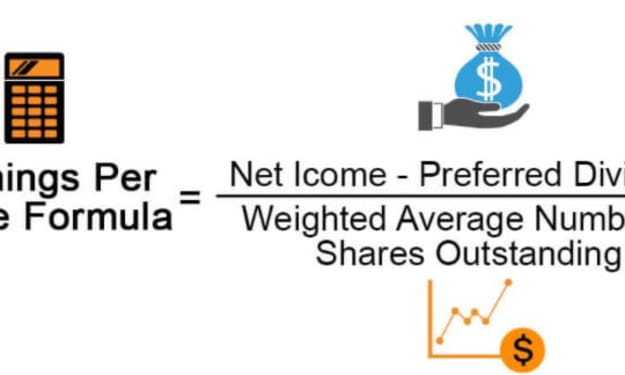Understanding the P/E Ratio: A Tool for Investment Analysis
Explaining the Price-to-Earnings Ratio and its Significance in Valuing Companies for Investors

Introduction:
When investing in the stock market, it's important to have a solid understanding of the company's valuation. One commonly used valuation metric is the price-to-earnings ratio, or P/E ratio. In this article, we will explore what the P/E ratio is, how to calculate it, and how it can be used as a tool for investment analysis.
What is the P/E Ratio?
The P/E ratio is a financial ratio that compares a company's current stock price to its earnings per share (EPS). In simple terms, it shows how much investors are willing to pay for each dollar of earnings that a company generates. The higher the P/E ratio, the more investors are willing to pay for each dollar of earnings, which may indicate that the company is overvalued.
How to Calculate the P/E Ratio?
The formula for calculating the P/E ratio is straightforward. It is calculated by dividing the current market price per share of a company by its earnings per share (EPS) over a specific time period. The EPS is the net profit of a company divided by the number of outstanding shares.
P/E Ratio = Current Market Price per Share / Earnings per Share
For example, if a company has a current market price of $50 per share and an EPS of $2, then its P/E ratio would be 25 (50/2).
The P/E ratio formula is derived from two components: the current market price per share and the earnings per share (EPS) of the company.
The market price per share is the current price that investors are willing to pay to buy one share of the company's stock. This price is determined by the supply and demand of the stock in the market.
The earnings per share is a measure of a company's profitability. It is calculated by dividing the company's net income by the total number of outstanding shares.
The P/E ratio is then calculated by dividing the current market price per share by the earnings per share of the company. This ratio indicates how much investors are willing to pay for each dollar of earnings that the company generates.
Types of P/E Ratios:
Trailing P/E Ratio: This is the most commonly used P/E ratio, which is calculated by dividing the current stock price by the company's earnings per share over the past 12 months.
Forward P/E Ratio: This is calculated by dividing the current stock price by the estimated earnings per share for the next 12 months.
Shiller P/E Ratio: Also known as the cyclically adjusted price-to-earnings (CAPE) ratio, this is calculated by dividing the current stock price by the average earnings per share over the past 10 years, adjusted for inflation.
Interpreting the P/E Ratio:
The P/E ratio is a useful tool for investors to evaluate the relative value of different companies. However, it should be used in conjunction with other financial metrics and analysis to make informed investment decisions.
A high P/E ratio does not necessarily mean that a company is overvalued. It could also indicate that the market expects strong future earnings growth for the company. Conversely, a low P/E ratio may indicate that the company is undervalued, or that the market has low expectations for future earnings growth.
It is also important to compare the P/E ratio of a company to its peers within the same industry. This can provide valuable insights into how the company is performing relative to its competitors.
Limitations of the P/E Ratio:
While the P/E ratio can be a useful tool for investment analysis, it does have its limitations. One limitation is that it does not take into account a company's debt levels, which can have a significant impact on its earnings and profitability.
Additionally, the P/E ratio is based on historical earnings, and does not reflect future earnings potential. It also does not consider other factors such as a company's growth prospects, competitive landscape, or industry trends.
How to Use the P/E Ratio in Investment Analysis:
When analyzing a company, it is important to consider the P/E ratio alongside other financial metrics and analysis. Here are some ways to use the P/E ratio in investment analysis:
Comparing P/E Ratios Across Industries: Comparing P/E ratios across industries can provide insight into how different industries are performing. For example, a higher P/E ratio in the technology industry may be considered normal, while a higher P/E ratio in the utility industry may be unusual.
Comparing P/E Ratios to Historical Averages: Comparing a company's current P/E ratio to its historical average can provide insight into whether the company is overvalued or undervalued relative to its historical performance.
Comparing P/E Ratios to Competitors: Comparing a company's P/E ratio to its competitors can provide insight into how the company is performing relative to its peers. This can help investors identify which companies are overvalued or undervalued in a particular industry.
Summarise
Have you ever heard of the stock market? It's a place where people can buy and sell small pieces of ownership in big companies, like Apple or Disney. When you buy a piece of ownership, or a share, you become a part-owner of the company.
Now, when you own a share of a company, you hope that the company will make a lot of money in the future. The more money the company makes, the more valuable your share of ownership becomes.
That's where the P/E ratio comes in. The P/E ratio is a way to figure out how much investors are willing to pay for each dollar that the company makes. It's like asking, "If the company makes $1, how much should someone pay to own a piece of the company?"
To figure out the P/E ratio, we take the current price of the company's stock (which is what people are paying to own a piece of the company) and divide it by the company's earnings per share (which is how much money the company made per share of ownership).
If the P/E ratio is high, it means that people are willing to pay a lot for each dollar the company makes. This could mean that investors expect the company to do really well in the future. But if the P/E ratio is low, it means that people are not willing to pay as much for each dollar the company makes. This could mean that investors don't expect the company to do as well in the future.
So, the P/E ratio is a way to see how much people are willing to pay for each dollar a company makes, which can give us a clue about how well investors expect the company to do in the future.
Conclusion:
The P/E ratio is a tool that helps investors figure out how much they should pay for each dollar that a company makes. It's calculated by dividing the company's stock price by its earnings per share. A high P/E ratio could mean that investors expect the company to do well in the future, while a low P/E ratio could mean they don't expect it to do as well. But, it's important to compare the P/E ratio of a company to its peers within the same industry, and remember that the P/E ratio has some limitations, like not taking into account a company's debt levels or future earnings potential.
About the Creator
Tag Business
I Will Providing Various Company Information
Enjoyed the story? Support the Creator.
Subscribe for free to receive all their stories in your feed. You could also pledge your support or give them a one-off tip, letting them know you appreciate their work.






Comments
There are no comments for this story
Be the first to respond and start the conversation.